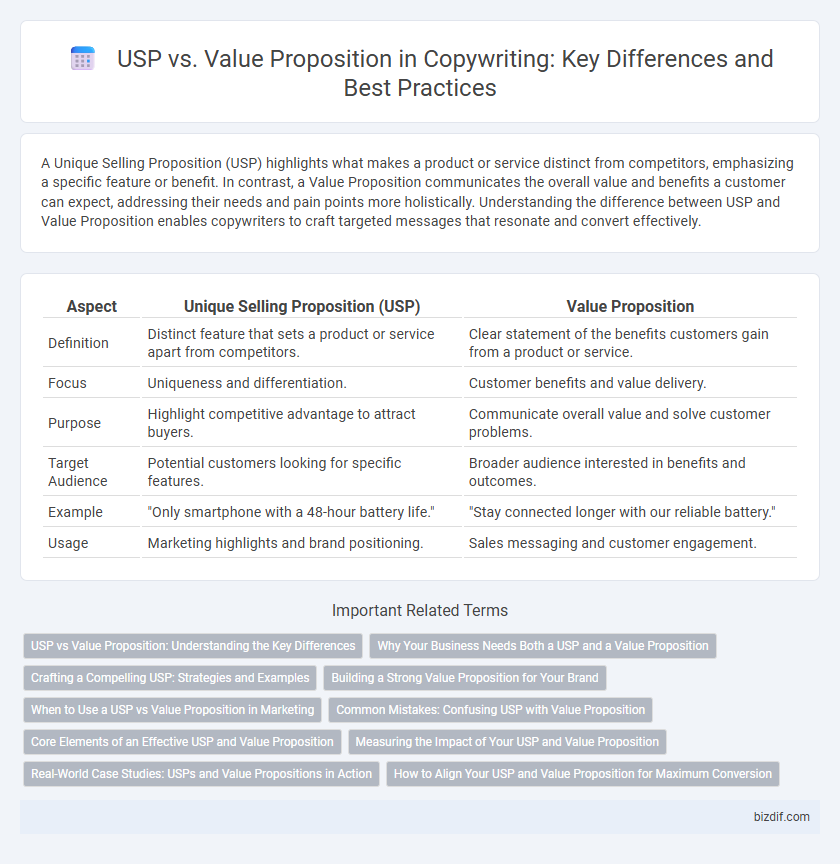A Unique Selling Proposition (USP) highlights what makes a product or service distinct from competitors, emphasizing a specific feature or benefit. In contrast, a Value Proposition communicates the overall value and benefits a customer can expect, addressing their needs and pain points more holistically. Understanding the difference between USP and Value Proposition enables copywriters to craft targeted messages that resonate and convert effectively.
Table of Comparison
| Aspect | Unique Selling Proposition (USP) | Value Proposition |
|---|---|---|
| Definition | Distinct feature that sets a product or service apart from competitors. | Clear statement of the benefits customers gain from a product or service. |
| Focus | Uniqueness and differentiation. | Customer benefits and value delivery. |
| Purpose | Highlight competitive advantage to attract buyers. | Communicate overall value and solve customer problems. |
| Target Audience | Potential customers looking for specific features. | Broader audience interested in benefits and outcomes. |
| Example | "Only smartphone with a 48-hour battery life." | "Stay connected longer with our reliable battery." |
| Usage | Marketing highlights and brand positioning. | Sales messaging and customer engagement. |
USP vs Value Proposition: Understanding the Key Differences
A Unique Selling Proposition (USP) highlights the distinct feature or benefit that sets a product or service apart from competitors, usually focusing on a single, compelling trait. In contrast, a Value Proposition communicates the overall experience and benefits a customer receives, encompassing emotional, functional, and economic value. Understanding the key differences between USP and Value Proposition enables marketers to craft more precise copy that clearly conveys both differentiation and comprehensive customer value.
Why Your Business Needs Both a USP and a Value Proposition
A Unique Selling Proposition (USP) distinguishes your brand by highlighting what makes your product or service different from competitors, while a Value Proposition clearly communicates the specific benefits and value customers can expect. Combining a USP with a compelling Value Proposition ensures your messaging resonates deeply with target audiences, driving engagement, trust, and conversions. Businesses that leverage both elements effectively create a competitive edge and foster strong customer loyalty in saturated markets.
Crafting a Compelling USP: Strategies and Examples
Crafting a compelling Unique Selling Proposition (USP) involves identifying the distinct benefit that sets a product or service apart from competitors, emphasizing specific features that resonate with target audiences. Effective strategies include focusing on emotional triggers, highlighting tangible outcomes, and integrating clear, concise messaging that aligns with customer pain points. Examples such as FedEx's "When it absolutely, positively has to be there overnight" demonstrate how a powerful USP communicates reliability and urgency, driving consumer preference and loyalty.
Building a Strong Value Proposition for Your Brand
Crafting a strong value proposition requires clearly communicating the unique benefits your brand offers, addressing customer pain points more effectively than competitors. Unlike a USP, which emphasizes distinct features, a value proposition centers on delivering measurable results and emotional appeal to target audiences. A compelling value proposition strengthens brand positioning by aligning product solutions with customer needs and expectations.
When to Use a USP vs Value Proposition in Marketing
Use a Unique Selling Proposition (USP) when highlighting a specific product feature that differentiates your offering from competitors in a clear, concise message. Opt for a Value Proposition to communicate the broader benefits and overall value your brand or product delivers to the customer, emphasizing emotional and functional outcomes. Marketers should apply a USP for targeted campaigns focused on differentiation, while a Value Proposition suits comprehensive brand messaging aimed at creating a strong customer connection.
Common Mistakes: Confusing USP with Value Proposition
Many businesses mistakenly use their Unique Selling Proposition (USP) and value proposition interchangeably, overlooking their distinct roles; the USP highlights what sets a product apart, while the value proposition communicates the overall benefit to the customer. This confusion often leads to unclear messaging that fails to resonate with target audiences or address their specific needs. Clarifying the difference enables copywriters to craft compelling content that differentiates the brand and drives customer engagement.
Core Elements of an Effective USP and Value Proposition
An effective Unique Selling Proposition (USP) centers on distinct features that set a product or service apart from competitors, emphasizing exclusivity and differentiation. The core elements of a Value Proposition highlight the specific benefits and solutions offered, directly addressing customer pain points and delivering clear, quantifiable value. Both leverage clarity, relevance, and customer-centric messaging to drive engagement and conversion.
Measuring the Impact of Your USP and Value Proposition
Measuring the impact of your USP (Unique Selling Proposition) and value proposition involves tracking key performance indicators such as conversion rates, customer retention, and brand awareness to gauge effectiveness. Implementing A/B testing and customer feedback analysis helps determine which messaging resonates most with your target audience and drives engagement. Quantitative metrics combined with qualitative insights provide a comprehensive evaluation of how well your USP and value proposition differentiate your brand and generate business growth.
Real-World Case Studies: USPs and Value Propositions in Action
Real-world case studies reveal that USPs (Unique Selling Propositions) emphasize distinct product features trusted by brands like Apple, which highlights innovative design and user experience. Value propositions focus on the comprehensive benefits and emotional impact, as demonstrated by Dove's campaign that promotes self-esteem and natural beauty to deepen customer connection. Analyzing these examples showcases how combining a strong USP with a compelling value proposition drives effective copywriting and customer engagement.
How to Align Your USP and Value Proposition for Maximum Conversion
Aligning your Unique Selling Proposition (USP) and value proposition ensures a clear, compelling message that resonates with your target audience and drives maximum conversions. Focus on identifying the core benefits that differentiate your product while directly addressing customer pain points and desires to create a cohesive narrative. Use data-driven insights to refine both elements, ensuring consistency across all marketing channels to build trust and influence purchase decisions effectively.
USP vs Value Proposition Infographic

 bizdif.com
bizdif.com